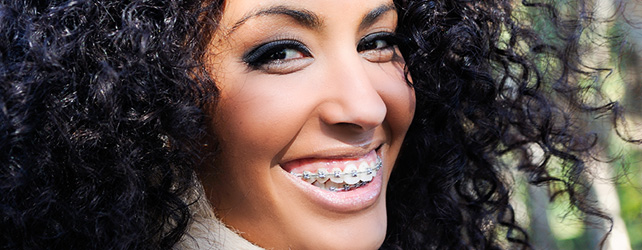
You’re never too old to have a beautiful, healthy smile. You may think that braces are only for children, and you’re an adult—you don’t have time; you don’t want to have wires in your mouth because it’s embarrassing; you think there’s nothing anyone can do anymore to give you a great smile. Well, think again. Braces may be the right answer for your teeth, for your confidence, and for your overall appearance.
What are braces?
Braces, or orthodontic braces, are used to straighten teeth and the position of them as well as correct overbite, underbites, crossbites, widely spaced teeth, or overly crowded teeth. They do this by putting pressure on your teeth, which then moves your teeth into a straighter position and lessens the gaps between your teeth. Dentists use the word malocclusion, which literally means “bad bite” to describe the shape of your teeth. Teeth that are positioned incorrectly can lead to chewing and speech problems. With braces, not only will your teeth straighten, but you’ll also notice improvements with chewing and speaking. During a dentist visit at Amedcoa Dental Center a branch of Pink Elephant Dental Studio you may be referred to go see an orthodontist, which are braces specialists.
When you think of braces, you might visualize a mouth full of metal. Today, braces are made to be much less noticeable, so you don’t have to hide that beautiful smile. You can get clear braces or braces that are the same color as your teeth; braces can also be hidden behind your teeth so no one can see them. Even though metal braces are still used today, the wires are a lot smaller and made from material that straightens your teeth easier and faster. If you think you need braces, you should discuss the options best for your teeth with your dentist.
Braces have many benefits. Braces can provide you with a higher self-esteem and self-confidence. You’ll notice a better appearance in your teeth and overall face. They also promote healthier, cleaner teeth because it will allow you to brush and floss your teeth better, which will prevent tooth decay and gum disease in the future. You’ll feel less strain on your muscles and joints; swallowing, chewing, and speech will also improve. Braces may be the answer for you so you can get a glowing, healthy smile!
How do I know that I need braces?
Usually it’s easy to tell whether or not you need braces. You might notice large gaps between you teeth, crowded teeth, teeth that are turned inward, an overbite, or an underbite. Also, you might feel jaw joint pain. These are all signs that you should look for. Sometimes only an x-ray or test can detect these signs, so it’s best that you speak to your dentist.
For children, thumb sucking, jaw grinding, early or late loss of teeth, accidents, or poor nutrition may be the cause of teeth growing in crooked. Most of time, crooked teeth are inherited from parents. This is why it’s important for parents to take their children to an orthodontist as they begin to grow.
Braces are not only for children! You may need braces, and it’s important that you speak to your dentist to see if they can help you get the smile you’ve always wanted.
Types of braces?
Invisalign are “invisible” braces that over a half a million people choose over regular metal braces. They consist of clear plastic trays that are custom-molded to your teeth so you’re guaranteed a smile that you’ll love. Invisalign is great because most people don’t notice you have them, and it won’t interrupt your daily life. There are no metal wires or annoying rubber bands inside your mouth, and best of all, you can brush and floss your teeth like you always do without worrying about food getting stuck in your braces. This is an advantage because maintaining good oral hygiene will help prevent tooth decay and buildup of plaque. These braces also don’t stain.
With Invisalign, you can remove your aligners for eating, brushing, or going out for special occasions. Invisalign has been successful for giving both teens and adults a great smile. You’ll be amazed at what Invisalign can do for you!
iBraces are unique braces that are placed behind your teeth so that no one will know that you’re wearing them. Since no two people are alike, either are iBraces; they are 100% customized to give your teeth the best treatment possible in the shortest amount of time. The brackets are customized to hug the surface of your teeth so that you’ll feel comfortable and have better results. The brackets are made of gold to help prevent allergies to nickel. iBraces are used to treat anyone who needs regular braces, including men and women from ages 13 and up. With iBraces, patients will notice immediate results. iBraces are great for a person who worries about wearing noticeable braces, professionals, musicians who play wind instruments, and anyone who plays contact sports.
Advantages of iBraces include fewer visits to the orthodontist, few wire adjustments, less discomfort, less damage to the front surface of the teeth, better speech, and faster results (varies patient to patient).
Ceramic and “tooth colored” braces have sturdy brackets that don’t usually stain and are made of composite minerals. They match the color of your teeth and are thus less noticeable compared to metal braces. Most people prefer these to metal braces because they’re less irritating to your mouth and gums. Ligatures, or tiny rubber bands, hold the thin metal wire on the brackets and are usually white or clear. These ligatures can stain, and unless you don’t eat a lot of curry, smoke, or drink coffee, you will notice the change in color. It’s important to know, however, that only the ligatures can stain, not the ceramic brackets! The good news is that ligatures have to be changed every 4-6 weeks by your orthodontist, so you’re not always stuck with stained ligatures.
Clear Sapphire Inspire braces are translucent and made from pure monocrystalline sapphire. The brackets are really strong and do not stain. If you have very white teeth, Inspire braces will look great on you because they’ll “vanish” on your teeth. However, if you have teeth that aren’t as white, these braces may stand out on your teeth. If this is the case, you’re better off with the ceramic braces (above). Like the ceramic braces, even though the brackets themselves don’t stain, the ligatures will. Again, your orthodontist has to change the ligatures every 4-6 weeks.
Metal braces are the traditional braces that we all know about. Metal brackets can be silver or gold, and since these brackets are extremely strong, they can endure most treatments. At first, you may experience some discomfort in the gums and cheeks, but after some time, your mouth will get used to them, and they won’t be a problem. Ligatures, tiny rubber bands, or metal tie wires are used to hold the wire onto the brackets. The advantages of metal braces are that the brackets never stain and rarely ever break.
Do braces hurt?
Braces that require brackets are bonded to the teeth with a very strong adhesive, and the only way you can break that bond is by eating hard and sticky foods. The procedure is painless and can take up to an hour to an hour and a half because of the drying time needed. Taking braces off is also painless, but requires time. While having braces, you may feel some discomfort because your teeth are just adjusting, but after some time, you will get used to it. It’s important to eat soft food, and stay away from foods that will stick in your braces or break the adhesive bond!
If you think you are allergic to latex or the metal used in braces, you should notify the orthodontist immediately so he or she can provide you with latex-free ligatures (rubber bands) and a different type of metal.
How do I care for my teeth with braces?
With braces, food can easily get stuck inside the brackets, which can lead to plaque buildup. For this reason, it’s important to brush properly after meals and keep your teeth extra clean. Your orthodontist might give you a special type of floss that will allow you to floss in and around your braces. You can also ask to floss your teeth before your orthodontist changes your wires because it’s easier to floss between teeth without the wires.
Having braces also requires you to be careful about what you eat because you don’t want to break any brackets, which can prolong your treatment time. You should avoid eating foods like popcorn, sticky or hard candy, large carrots, large hard pretzels and chewing gum. It’s okay to drink sugary sodas and juices as long as you brush your teeth afterwards; sugary drinks can cause problems for teeth as well.
If you notice a loose wire or bracket, or feel the wire poking the inside of your mouth, you should immediately see your orthodontist at Pink Elephant Dental Center so they can take care of it. He or she also may give you some soft wax, which you put over the brackets that are bothering you. This will help for the irritation from your braces. If you play contact sports, it’s important that you wear a mouth guard to help protect your braces from damage.
When do I get my braces off?
Every patient’s dental needs are different, and it all depends on your teeth. At Pink Elephant Dental Center, your orthodontist can only estimate how long you will need to wear your braces; how well you take care of your teeth with braces can also prolong the treatment time. You might have to wear braces anywhere from 6 to 30 months.
What happens after I get my braces taken off?
With regular braces, retainers need to be worn because the teeth can shift out of position after braces have been removed. A retainer is a hard piece of plastic with metal wires, which is molded to fit your teeth so no two retainers are alike. They help your teeth stay in place until your bones and gums get used to the treatment changes. By following instructions on how to wear your retainer, how long to wear it, and how to take care of your teeth once braces are removed, your treatment will last longer. Don’t be alarmed if your teeth start to change as you age—this is normal (they don’t stay perfect forever)! It just means that you need to see your dentist to help you figure out the best treatment for you. If you don’t continue to wear your retainer like instructed, your teeth will most likely return to their original position; this is called relapse. You don’t want this to happen!
Your retainer can have bacteria, plaque, and food particles on it, so it’s important that you clean your retainer every day by removing it and brushing it with a toothbrush and toothpaste. To kill germs, you can soak your retainer in mouthwash or denture-cleaning solution. Also, the plastic of the retainer can crack easily if it gets too dry, so when you’re not wearing it, you should soak it. Plastic also go out of shape easily, so you should avoid putting your retainer in hot water or leaving it near a heat source like a radiator.
If a retainer is not proper for a person’s teeth, the orthodontist will give them a pre-finisher to wear. This is made of rubber, and it looks like a mouth guard. A pre-finisher helps fix gaps between teeth and other minor problems that could get worse. Dental braces cannot fix these problems because they are small. A pre-finisher, like a retainer, is not permanent and can be removed from mouth.
 You’re never too old to have a beautiful, healthy smile. You may think that braces are only for children, and you’re an adult—you don’t have time; you don’t want to have wires in your mouth because it’s embarrassing; you think there’s nothing anyone can do anymore to give you a great smile. Well, think again. Braces may be the right answer for your teeth, for your confidence, and for your overall appearance.
You’re never too old to have a beautiful, healthy smile. You may think that braces are only for children, and you’re an adult—you don’t have time; you don’t want to have wires in your mouth because it’s embarrassing; you think there’s nothing anyone can do anymore to give you a great smile. Well, think again. Braces may be the right answer for your teeth, for your confidence, and for your overall appearance.

 You’re never too old to have a beautiful, healthy smile. You may think that braces are only for children, and you’re an adult—you don’t have time; you don’t want to have wires in your mouth because it’s embarrassing; you think there’s nothing anyone can do anymore to give you a great smile. Well, think again. Braces may be the right answer for your teeth, for your confidence, and for your overall appearance.
You’re never too old to have a beautiful, healthy smile. You may think that braces are only for children, and you’re an adult—you don’t have time; you don’t want to have wires in your mouth because it’s embarrassing; you think there’s nothing anyone can do anymore to give you a great smile. Well, think again. Braces may be the right answer for your teeth, for your confidence, and for your overall appearance.
